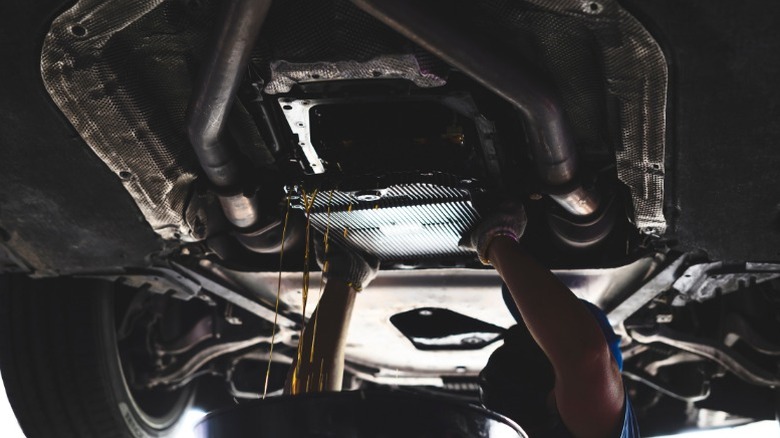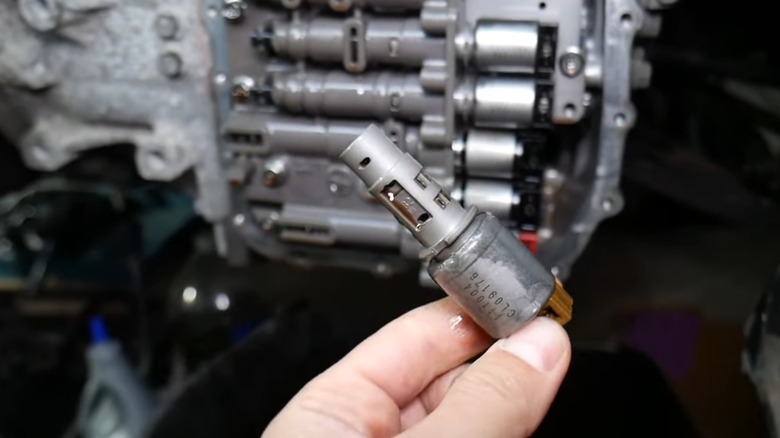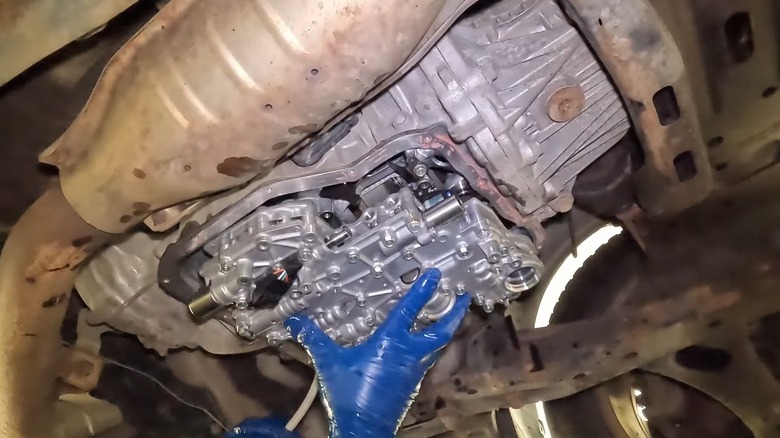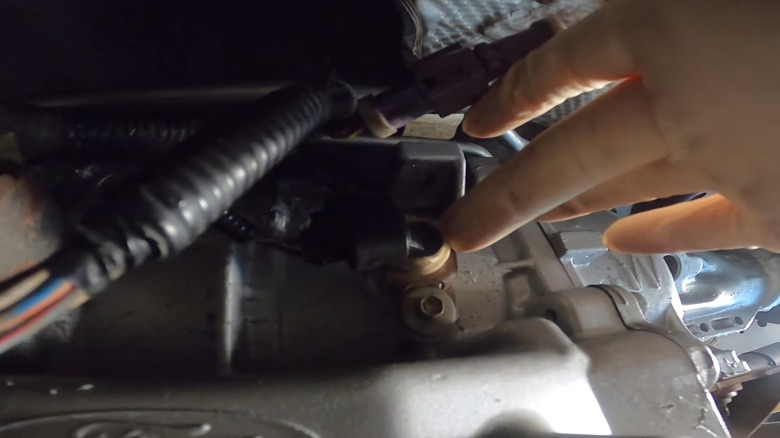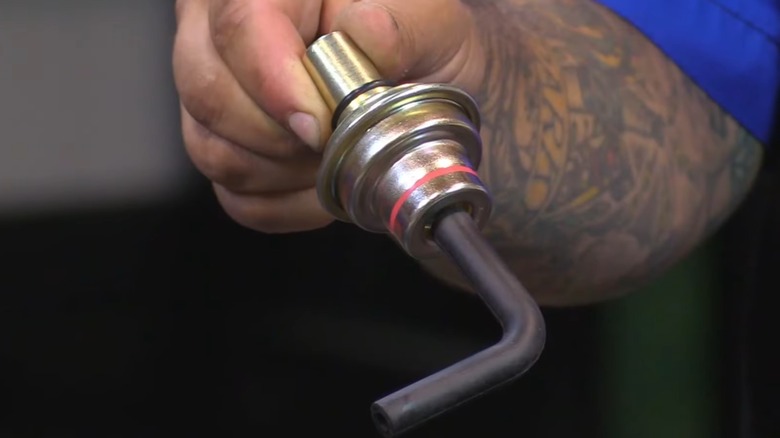What It Means If Your Transmission Is Shifting Hard (And The Possible Fixes A Mechanic Might Suggest)
The automatic transmissions found in many modern vehicles are marvels of engineering. They rely on a huge number of internal parts, like clutch packs, various gears, solenoids, a valve body, hydraulic fluid, and more to send us down the road at different speeds. Your transmission is the reason you're able to take off from a stopped position, and it's also the reason why you're able to slow the engine power down when it's time to stop. However, despite your transmission's importance, it's not immune to damage over time. That's especially true if you fail to keep up with routine gearbox maintenance, like transmission fluid flushes. When your transmission has a problem, it can cause various symptoms, including everything from hard shifts and strange smells to the complete inability to shift into gear.
Transmission issues are serious and not something you should take lightly. Hard shifts, in particular, are often one of the first signs of transmission trouble. Ignoring them can lead to greater damage down the road, as well as significantly more expensive repairs. Unfortunately, hard shifting can be a sign of various transmission problems, which can make the diagnostic process tricky.
If you're curious about some of the issues that can cause a transmission to shift hard, we've got you covered. As a former professional auto repair technician who has repaired and diagnosed innumerable faulty transmissions, I'll break it down for you. From low or poor quality transmission fluid to damaged solenoids and more, here's what it means if your transmission is shifting hard and some of the possible fixes your mechanic may suggest.
Low or contaminated transmission fluid
One of the most common causes of a hard shifting transmission is low or dirty transmission fluid. Transmission fluid is a type of hydraulic fluid used to perform tasks like actuating solenoids and clutch packs inside the gearbox, as well as providing lubrication to prevent friction and heat buildup. Like engine oil, transmission fluid degrades and loses its ability to work properly over time. Depending on your vehicle, you need to replace your transmission fluid roughly every 30,000 to 100,000 miles, and you can learn more about your car's transmission service intervals by reading your vehicle owner's manual. Failing to maintain the fluid properly can result in various problems, including things like overheating issues, hard shifts, and even complete transmission failure.
Hard shifts are likely to occur if your transmission fluid level drops too low because the system won't have enough fluid pressure or lubrication to actuate gear changes properly. This can result in a jerky or lurching feeling as your vehicle shifts, and it can be one of the first signs of deeper transmission problems. On the other hand, dirty or contaminated fluid can cause blockages in the transmission and result in grime buildup, preventing things like valves and clutch packs from functioning properly. This can also cause your transmission to shift hard, as well as cause damage to sensitive internal components, which may cause further damage over time.
Fortunately, avoiding issues caused by low or dirty transmission fluid is relatively easy. If you visit a mechanic for an inspection, and they tell you that your transmission fluid is to blame for hard shifts, they'll most likely recommend a transmission fluid change or flush, as long as the poor quality fluid hasn't already caused deeper problems, that is.
Worn-out transmission solenoids
Another potential cause of a hard shifting transmission is a damaged or worn-out transmission solenoid. Transmission solenoids are electro-hydraulic valves responsible for controlling the flow of hydraulic transmission fluid through the valve body to manage how the gearbox shifts. They work closely with the transmission control module (TCM), which monitors things like engine power and your vehicle's transmission speed sensors, to route hydraulic pressure to the valve body and determine the correct gear for your current driving situation. While transmission solenoids are robust components, they are subject to wear and tear over time, as well as damage caused by other conditions, like inadequate or contaminated transmission fluid.
Transmission solenoids can cause a hard shifting transmission if the fluid level is low or dirty, if they experience an electrical malfunction, and due to wear over time. We've already covered the importance of clean and adequate transmission fluid. However, even if you replace your transmission fluid, the solenoids may become damaged or stuck in an open or closed position if you wait too long between fluid replacements. Alternatively, electrical connections and components inside the solenoids can fail due to various issues. When these issues occur, you're likely to begin experiencing hard shifts, along with various other problems, like stuck or slipping gears or the activation of your vehicle's limp mode setting.
If you bring your car to a mechanic to inspect the transmission, and they determine that you have a bad solenoid, they'll most likely recommend replacing the worn-out part. Depending on the vehicle, replacing a transmission solenoid can be relatively straightforward or complex, and you're likely to pay anywhere from $100 to upwards of $400 for the repair.
Valve body damage
Your transmission's valve body is a network of fluid channels that route hydraulic fluid to different parts of the gearbox. It contains valves and check balls that function like gates, allowing fluid to move through passages to actuate different gears, and works with the transmission solenoids to facilitate the flow of fluid. Most transmission valve bodies can be found beneath the transmission drain pan and are constructed of cast iron or aluminum.
Transmission valve bodies are engineered to be robust and durable components. However, that doesn't mean that they're immune to wear and tear over time or other forms of damage. As with the previous issues covered above, low or dirty transmission fluid can cause the valve body to develop damage, especially if sludge or grime is able to build up in the fluid passages or interfere with the solenoids. Valve bodies can also develop damage due to basic wear and tear over time, and these issues may take the appearance of warped fluid channels. If your valve body does develop damage or wear, you're likely to experience issues like hard shifting, slipping gears, the appearance of a check engine light, and more.
To diagnose a faulty transmission valve body, you'll most likely require a professional inspection, unless you're an experienced home mechanic. If your repair shop determines that the valve body is to blame for your hard shifting transmission, they may recommend replacing it. However, the procedure can be pricey, depending on your car and the labor rates in your area. Factoring in the mechanic's labor and the cost to purchase new parts, you'll likely be looking at a total price of between $400 to over $2,500 for a replacement valve body.
Damaged or worn-out speed sensors
Modern cars rely on a massive number of electronics, sensors, and computer systems to send you down the road. Most of these components have individual responsibilities and work primarily in one system. However, many of these parts also share data amongst each other, and several of them cooperate with other systems to provide a smooth driving experience. When it comes to your transmission, we've mentioned solenoids and the transmission control module, but modern gearboxes also rely on a series of speed sensors, too.
Most modern transmissions have two speed sensors: an input sensor and an output sensor. The input sensor monitors the speed of the transmission's input shaft, which connects to the engine and supplies the transmission with its power, while the output speed sensor monitors the speed of the gearbox's output shaft, which is what sends power to the driveline and, in turn, your wheels. The TCM reads the data that the speed sensors collect and uses that information to adjust the gear ratio and hydraulic fluid pressure. However, if either one of the sensors fails, the TCM will be unable to adjust the gears accurately, potentially leading to hard shifts, the inability to enter cruise control, and a check engine light.
If your mechanic determines that your transmission shifting problems are due to a faulty speed sensor, they'll probably recommend a replacement. Prices can vary depending on your car's make and model, as well as labor rates in your area. However, you should expect to pay between $150 and $350. That said, replacing a transmission speed sensor can be a great DIY auto job any beginner can tackle. Even if you're not experienced with cars, you can grab a vehicle-specific repair manual, and you shouldn't have many issues knocking it out at home.
Issues with the vacuum system
If you drive an older vehicle with an automatic transmission, it may rely on, in part, on the vehicle's vacuum system and a governor mechanism to assist with gear changes. While most modern cars with automatic transmissions rely on a series of electronics to tell the gearbox when and how to shift, older vehicles rely on a vacuum modulator valve and a governor to monitor engine output and adjust the transmission gear setting accordingly.
For vehicles that use this style of transmission, the modulator valve relies on engine vacuum to help determine the transmission gear setting. As you depress the gas pedal or let up on the gas, engine vacuum decreases or increases. The modulator valve monitors this engine vacuum, while the governor monitors engine speed. The combined data collected by these components is used to adjust the transmission so that the gear ratio matches your current driving needs.
Unfortunately, automotive vacuum systems can be prone to damage, thanks to their dependence on rubber hoses. These vacuum lines can crack or split, developing leaks, or become clogged, bent, or otherwise damaged. When this occurs, you're likely to experience various issues, including a harsh shifting transmission if you drive an older vehicle. If your mechanic determines that your rough shifting gearbox is the result of a vacuum system problem, they'll have to identify the leak or damage using a smoke machine or pressure test. Then, they'll most likely recommend a replacement. Vacuum system repair prices can vary depending on the type of damage. However, for simple hose replacements, you should expect to pay around $75 to $100, while other vacuum system repairs, including a vacuum modulator replacement, can cost anywhere from $150 to over $1,000.

